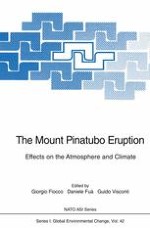1996 | OriginalPaper | Buchkapitel
Tropical stratospheric Ozone ChangesFollowing the Eruption of Mount Pinatubo
verfasst von : William B. Grant
Erschienen in: The Mount Pinatubo Eruption
Verlag: Springer Berlin Heidelberg
Enthalten in: Professional Book Archive
Aktivieren Sie unsere intelligente Suche, um passende Fachinhalte oder Patente zu finden.
Wählen Sie Textabschnitte aus um mit Künstlicher Intelligenz passenden Patente zu finden. powered by
Markieren Sie Textabschnitte, um KI-gestützt weitere passende Inhalte zu finden. powered by
The eruption of Mount Pinatubo in June 1991 placed a large amount of SO2 in the stratosphere which was converted to sulfuric acid aerosols in 2-3 months after the eruption. These aerosols remained primarily in the tropical stratospheric reservoir (TSR) for the first 6 months or so after the eruption before being largely dispersed to midlatitudes. The large amount of SO2 and aerosols in the TSR was sufficient to cause easily observable changes in stratospheric ozone. There was an initial 2% column increase caused by photooxidation of SO2, followed by a 5% column decrease in the region from the Equator to 10 deg. S in the August-November 1991 period based on total ozone mapping spectrometer (TOMS) data. A comparison of electrochemical concentration cell (ECC) sonde data at Brazzaville (4°s) and Ascension Island (8°s) with the historical pre-Pinatubo stratospheric aerosol and gas experiment II (SAGE II) ozone data showed indicated a 8% column decrease between 16 and 28 km along with a 2% column increase between 28 and 32 km. The decrease from 16 to 28 km is likely due primarily to a combination of aerosol heating and lofting of the associated air mass and aerosol effects on photolysis, with small contributions from heterogeneous chemistry involving the aerosols. The increase above 28 km is primarily due to the removal of NO2 by the aerosols, permitting the photochemical production of ozone to be more efficient. The phase change of the QBO from easterly to westerly was delayed by the rising motion of the aerosols by about 10 months, resulting in about a 10-D.U. decrease of ozone for that period compared to what would have been the case without the delay. In addition, in the middle of 1992, there was another minimum in stratospheric ozone in the Equator-to-10°S region, beyond that expected from QBO effects, which is not explained.
